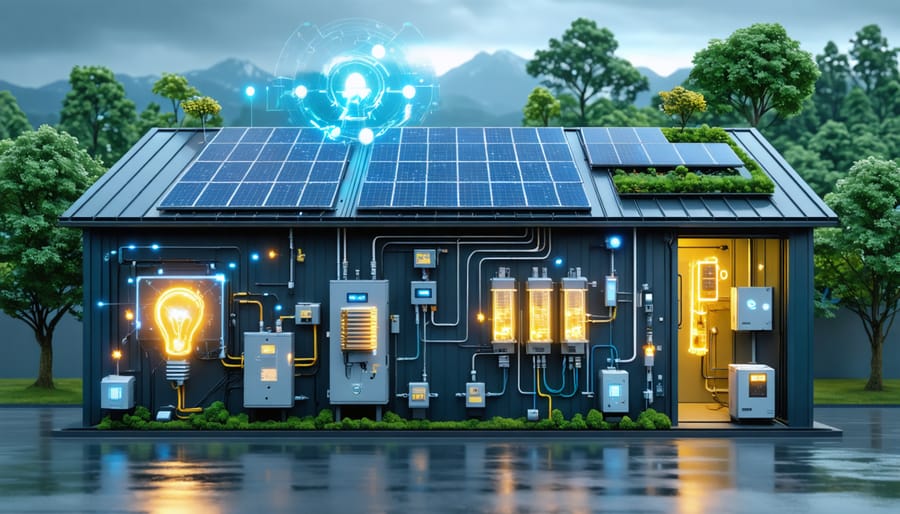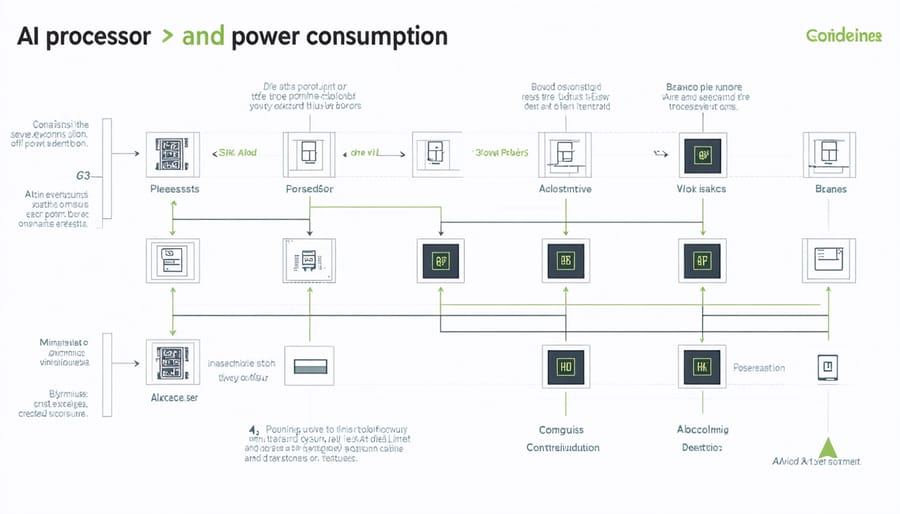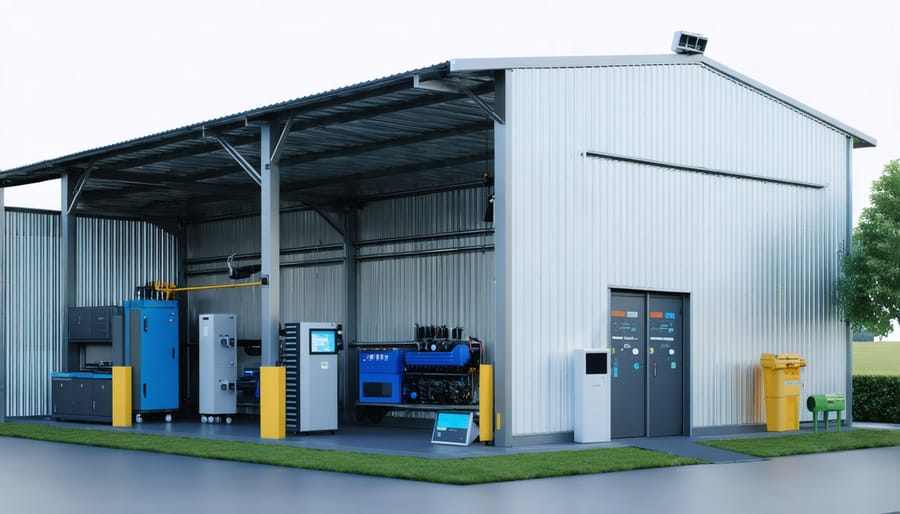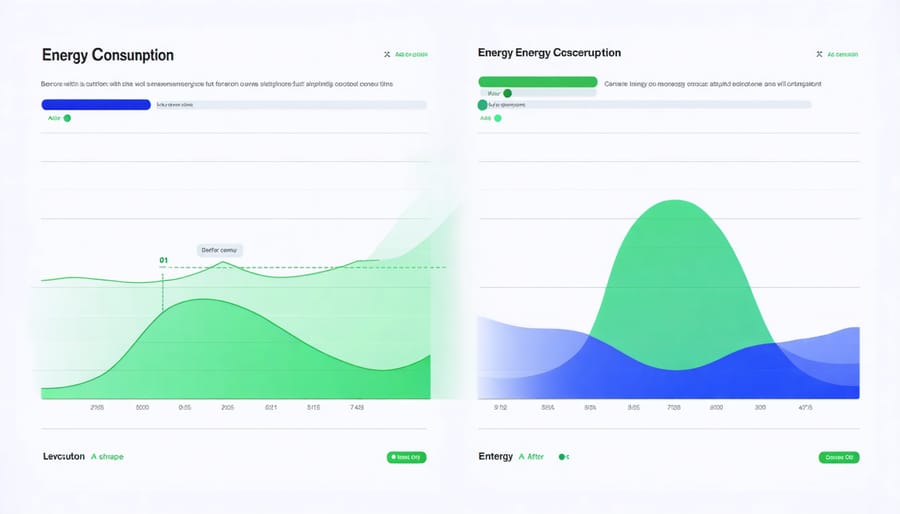Smart Shed Power: How AI Transforms Your Storage Space’s Energy Use

Artificial Intelligence revolutionizes our energy landscape, consuming substantial electricity while simultaneously offering innovative solutions to manage it. Modern AI systems, from small-scale smart home assistants to massive data centers, require significant power to process millions of calculations per second. A single AI training model can use as much electricity as five American households do in a year. Yet, these same systems are becoming instrumental in helping homeowners optimize their energy usage, particularly in storage spaces and outbuildings.
The growing intersection between AI and energy consumption raises important questions about sustainability and practical applications for everyday property owners. As more homeowners integrate smart technology into their storage solutions, understanding AI’s power requirements and benefits becomes crucial for making informed decisions about energy management. This dual nature of AI – as both an energy consumer and an energy optimization tool – creates unique opportunities for those looking to balance technology adoption with energy efficiency in their storage spaces.
How AI Systems Process Electricity
The Core Power Needs of AI Systems
AI systems rely on several key components that require electricity to function effectively. At the heart of these systems are powerful processors, similar to the ones in your computer but often much more sophisticated. These processors work continuously to analyze data, make decisions, and learn from new information, consuming significant amounts of power in the process.
The sensors that AI systems use to gather information about their environment also need constant power. Think of these as the AI’s eyes and ears – they’re always on, collecting data to help the system make informed decisions. Just like how your smartphone’s sensors use battery power to detect movement or light, AI sensors need a steady supply of electricity to function properly.
Additionally, AI systems require power for their memory components and cooling systems. The memory units store vast amounts of data needed for AI operations, while cooling systems prevent overheating during intensive processing tasks. Together, these components form the core power needs of any AI system, whether it’s a smart home assistant or a more complex industrial application.

Energy Efficiency in Modern AI Technology
Modern AI technology has made significant strides in reducing its energy footprint through innovative approaches to power management. Companies are developing more efficient processors and implementing smart algorithms that optimize power usage during both active and idle periods. These improvements include dynamic voltage scaling, where the system adjusts power consumption based on workload, and efficient data processing techniques that minimize unnecessary calculations.
Recent developments in AI hardware have introduced specialized chips that perform complex calculations with less energy consumption than traditional processors. Cloud providers are also implementing energy-saving features like automated resource allocation and workload scheduling to reduce power waste during off-peak hours.
Additionally, AI systems now incorporate smart cooling solutions and energy-efficient data storage methods. By using adaptive power management and sophisticated scheduling algorithms, modern AI installations can reduce their electricity consumption by up to 30% compared to older systems. These advancements not only lower operational costs but also contribute to a more sustainable technological future.
AI-Powered Energy Management for Your Shed

Smart Sensors and Data Collection
Modern AI systems employ sophisticated sensor networks and data collection methods to monitor and optimize energy consumption patterns. These smart sensors work continuously to gather information about temperature, humidity, occupancy, and equipment performance, creating a comprehensive picture of how electricity is being used in real-time.
The sensors can detect when certain areas or devices are consuming more power than necessary and automatically adjust settings to reduce waste. For example, in storage environments, AI-powered systems can learn your usage patterns and automatically dim lights in unused areas or adjust climate control settings based on actual needs rather than fixed schedules.
Data collection goes beyond simple power readings. AI systems analyze historical usage patterns, weather conditions, and even equipment performance metrics to make predictive decisions about energy management. This might include identifying when equipment needs maintenance to prevent energy-inefficient operation or suggesting optimal times for running power-hungry devices.
The beauty of these systems lies in their ability to learn and adapt over time. As they collect more data about your specific usage patterns, they become increasingly efficient at managing power consumption. Many homeowners report seeing noticeable reductions in their electricity bills within the first few months of implementing AI-driven energy management systems, making them a smart investment for long-term energy savings.
Predictive Analytics in Action
In today’s smart homes and businesses, AI systems are actively making energy-saving decisions that demonstrate their value in reducing electricity consumption. For example, Google’s DeepMind AI reduced data center cooling costs by 40% by analyzing thousands of sensors and adjusting cooling systems in real-time. This same technology is now being adapted for home use through smart thermostats that learn your preferences and optimize heating and cooling cycles.
Storage facilities are also benefiting from AI-powered systems that automatically adjust lighting and climate control based on occupancy patterns and weather conditions. These systems can predict peak usage times and adjust power consumption accordingly, leading to significant energy savings.
In manufacturing, AI algorithms are helping production lines reduce electricity waste by identifying inefficient equipment and suggesting optimal operating schedules. One automotive plant reported a 20% reduction in energy costs after implementing AI-driven predictive maintenance and power management systems.
Even in everyday households, smart home systems are using AI to learn when to run power-hungry appliances during off-peak hours, automatically dim lights in unused rooms, and adjust HVAC settings based on occupancy patterns. These practical applications show how AI isn’t just consuming electricity – it’s actively helping us use it more wisely.
Cost Benefits and Energy Savings
Real Cost Savings
Real-world examples show impressive cost savings when AI manages energy consumption. A study of smart home systems revealed average household savings of 15-25% on monthly electricity bills. For instance, the Johnson family in Minnesota reported a $45 monthly reduction after implementing AI-controlled lighting and temperature management in their storage shed workshop.
Smart scheduling plays a crucial role in these savings. AI systems learn usage patterns and automatically adjust power consumption during peak and off-peak hours. One homeowner’s garden shed, equipped with AI-controlled ventilation and heating, saw a 30% decrease in energy costs during winter months by optimizing temperature settings based on weather forecasts and usage times.
Commercial applications show even more dramatic results. A network of climate-controlled storage facilities implemented AI energy management and reduced their electricity costs by 40% within the first year. The system learned to adjust cooling and heating cycles based on occupancy patterns and external temperatures.
These savings extend beyond just lower bills. AI-managed systems also help reduce maintenance costs by identifying potential issues before they become major problems, while extending the lifespan of electrical equipment through optimized usage patterns.

Environmental Impact
The environmental impact of AI’s electricity consumption presents a complex balance of challenges and opportunities. While AI systems do require significant power to operate, they’re increasingly being optimized for energy efficiency. Modern AI implementations often include power-saving features that automatically adjust processing loads based on demand, reducing unnecessary energy use.
Many organizations are implementing green initiatives alongside their AI deployments. For instance, data centers housing AI systems are increasingly powered by renewable energy sources like solar and wind power. Some facilities have achieved remarkable sustainability milestones, with several tech giants committing to carbon-neutral AI operations by 2025.
The positive environmental effects of AI extend beyond direct energy consumption. AI systems help optimize power grids, reduce waste in manufacturing processes, and improve building energy efficiency. Smart building systems using AI can reduce energy consumption by 20-30% through intelligent climate control and lighting management.
Looking ahead, researchers are developing more energy-efficient AI algorithms and hardware. These innovations focus on reducing computational complexity while maintaining performance, ensuring that as AI becomes more prevalent, its environmental footprint becomes increasingly sustainable. The key lies in balancing AI’s power requirements with its potential to drive broader environmental benefits through improved resource management and efficiency.
Simple Setup Steps for Your Smart Shed
Getting your smart shed up and running with AI-powered energy management doesn’t have to be complicated. Start by selecting a reliable smart hub that’s compatible with your existing home automation system. Popular choices like SmartThings or Home Assistant work well for implementing AI energy management systems in storage spaces.
Begin with installing a smart power meter at your shed’s main electrical connection. This provides real-time energy usage data that the AI can analyze. Next, add smart plugs to monitor individual devices and equipment. Motion sensors and smart lighting should be positioned strategically – typically near entrances and frequently accessed areas.
For temperature control, install a smart thermostat if you have heating or cooling units. Add humidity sensors to protect sensitive items stored inside. Connect everything to your Wi-Fi network, ensuring stable coverage reaches your shed. Most systems come with user-friendly apps that guide you through the setup process.
Don’t forget to set up automated routines – like turning off unnecessary power usage during nighttime hours or adjusting temperature based on weather conditions. Start simple with basic automation and gradually add more features as you become comfortable with the system. Many homeowners find that this stepped approach helps them maximize energy savings while maintaining convenient access to their storage space.
Remember to regularly check your system’s performance through the app and adjust settings as needed for optimal efficiency.
Implementing AI-powered energy management in your storage space is a smart investment that pays dividends in both convenience and cost savings. By monitoring and optimizing electricity usage, these systems help reduce your monthly utility bills while ensuring your stored items remain protected in optimal conditions. The ability to control lighting, ventilation, and climate settings remotely adds an extra layer of security and peace of mind. Whether you’re storing temperature-sensitive items or simply want to maintain an energy-efficient space, AI technology offers a practical solution that’s becoming increasingly accessible to homeowners. With user-friendly interfaces and straightforward installation options, there’s never been a better time to upgrade your storage space with intelligent energy management. Make the switch today and join the growing number of homeowners who are embracing smarter, more sustainable storage solutions.

